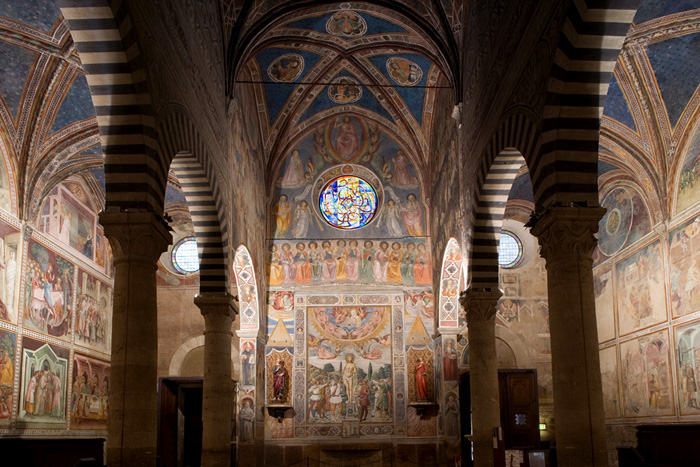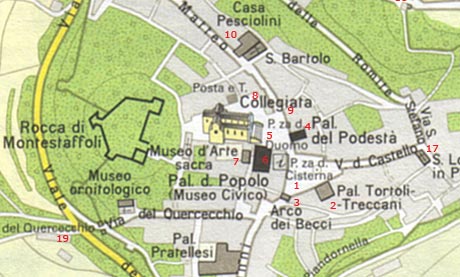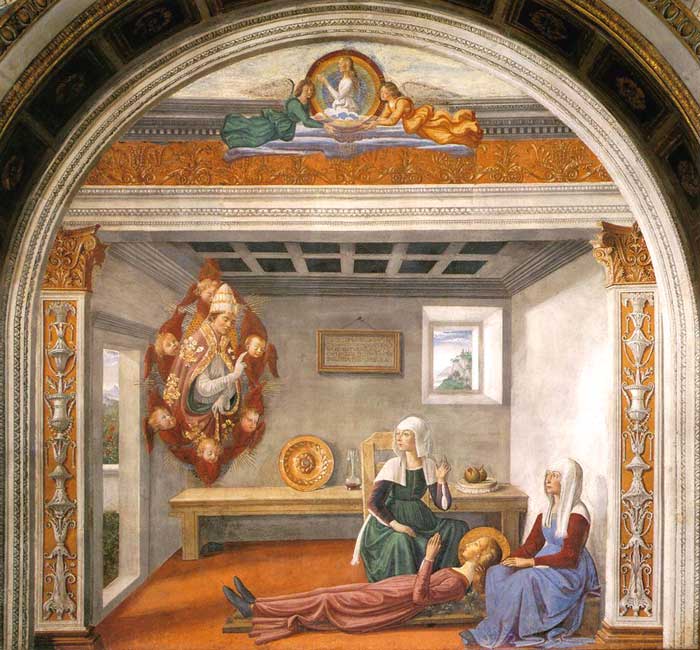| |
|
San Gimignano stands on a hill dominating the Val d'Elsa, immersed in the extraordinary landscape of Tuscany, 56 km south of Florence.
The Piazza del Duomo is the heart of San Gimignano, just as it was the centre of political and religious life in the Middle Ages. Entering Piazza del Duomo from Piazza della Cisterna, on the left you can see the Palazzo Comunale, which stands next to the staircase leading to the entrance of the Duomo. The Basilica Collegiata di Santa Maria Assunta (or Chiesa Collegiata) is a remarkable monument of Romanesque architecture in Tuscany. The church is famous for its fresco cycles which include works by Domenico Ghirlandaio, Benozzo Gozzoli, Taddeo di Bartolo, Lippo Memmi and Bartolo di Fredi. The basilica is located within the UNESCO World Heritage Site of the "Historic Centre of San Gimignano", with its frescos being described by UNESCO as "works of outstanding beauty".[2]
|
|
|
1 |
Piazza della Cisterna |
2 |
Palazzo Tortoli |
3 |
Arco dei Becci |
4 |
Palazzo del Podestà |
5 |
Piazza del Duomo |
6 |
Palazzo del Popolo |
7 |
Museo d'Arte Sacra, Museo Etrusco |
8 |
Torri Salvucci |
9 |
Palazzo Cancelleria |
10 |
Palazzo Pesciolini |
11 |
Palazzo Tinacci |
12 |
San Pietro |
13 |
Piazza Sant'Agostino |
14 |
San Iacopo |
15 |
Porta San Iacopo |
16 |
Porta d. Fonti |
17 |
San Lorenzo in Ponte |
18 |
Porta San Giovanni |
19 |
Porta Quercecchio |
20 |
Porta San Matteo |
View larger map |
| |
|
|
The heart of San Gimignano contains four squares, Piazza della Cisterna, Piazza Duomo where the Collegiata is located, Piazza Pecori, and Piazza delle Erbe. The main streets are Via San Matteo and Via San Giovanni, which cross the city from north to south.
Piazza della Cisterna represents the middle of the village, it has a triangular shape and it takes the name from the cistern placed inside the square, built in 1237 and enlarged in 1346. The Piazza del Duomo is paved and surrounded with buildings and towers. On a high stairs, dominates the Collegiate Church of S. Maria Assunta (XII century).
The Chiesa Collegiata, the Duomo of San Gimignano, dates from the 12th century. It is a splendid building with all of its medieval features preserved. The 13th -14th century urban structure of San Gimignano has remained remarkably well intact, and in 1929 the entire town was classified a protected monument, while in 1990 it received the prestigious designation of UNESCO “World Heritage Site.”
The Chiesa Collegiata
The façade dates from 1239 and is remarkably plain. The Pisan Romanesque interior is famous for its lavish frescoes, which almost entirely cover the walls. The arcades are of black and white striped marble. In the centre is a large fresco of "St Sebastian" by Benozzo Gozzoli (1465), commissioned after the plague had hit the town in 1464. A fresco cycle by Taddeo di Bartolo depicts the "Last Judgement" in gruesome detail. The two main chapels are the Cappella di San Gimignano, with an altar by Benedetto da Maiano, and the Cappella di Santa Fina, designed by Giuliano da Maiano, with the sculpture by his brother Benedetto. Domenico Ghirlandaio painted the frescoes in the latter chapel. St Fina was born in San Gimignano in 1238, contracted an incurable disease when she was ten and spent the five years until her death lying on a board to increase her suffering before God. On her death the board was covered in flowers.
Decoration
|
|
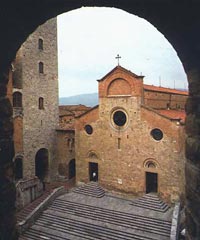
Duomo or Chiesa Collegiata

Campanile della Collegiata
|
The Romanesque architectural details of the church's interior are emphasised by the decorative use of colour, with the voussoirs of the nave arcades being of alternately black and white marble, creating stripes, as seen at Orvieto Cathedral. The vault compartments are all painted with lapis lazuli dotted with gold stars, and the vaulting ribs are emphasised with bands of geometric decoration predominantly in red, white and gold.
The church is most famous for its largely intact scheme of fresco decoration, the greater part of which dates from the 14th century, and represents the work of painters of the Sienese school, influenced by the Byzantine traditions of Duccio and the Early Renaissance developments of Giotto. The frescoes comprise a Poor Man's Bible of Old Testament cycle, New Testament cycle, and Last Judgement, as well as an Annunciation, a Saint Sebastian, and the stories of a local saint, St Fina, as well as several smaller works.
The Stories of St Fina by Domenico Ghirlandaio
Old Testament cycle
New Testament cycle
The Last Judgementby Taddeo di Bartolo
Other ASt Sebastian by Benozzo Gozzoli
Works by Jacopo della Quercia and others
|
The Stories of St Fina by Domenico Ghirlandaio
|
|
|
|
Domenico Ghirlandaio, Announcement of Death to St Fina, 1473-75, one of the Renaissance frescoes in the Santa Fina Chapel
|
| |
|
|
Between 1468 and 1472, architect Giuliano da Maiano built Saint Fina's mortuary chapel in the collegiate church and Domenico Ghirlandaio covered the walls with frescoes. His brother Benedetto da Maiano created the saint's burial altar about 1475. Both artists were working in direct competition with each other, for they were depicting the Obsequies of Saint Fina side by side, each using his own medium, fresco and relief carving.
It was in the frescoes for this chapel Ghirlandaio was able to develop his own style. The two frescoes in the Saint Fina Chapel are the first major works of Ghirlandaio's career. There are already signs of the architecture that will feature in his later works, here imaginatively and skillfully constructed according to the laws of perspective.
There are two Stories of St Fina: the Apparition to Fina of St Gregory who announces her Death and the Obsequies of the Saint. The immediate inspiration for the composition of the Obsequies of the Saint was Fra Filippo Lippi's fresco in the choir of Prato Cathedral, the Obsequies of Saint Stephen. Ghirlandaio would later create another variation on this composition in a fresco for the Sassetti Chapel in Florence.
Announcement of Death to St Fina
Fina, the pious daughter of poor parents, died on the feast day of Saint Gregory in 1253 after a long and painful illness. She was just fifteen years old. According to legend, after the death of her mother Fina lived an ascetic lifestyle so strict she was, in the end, scarcely able to move. Vermin and rats gnawed at her body until death finally liberated her from her prolonged sufferings. Pope Gregory the Great, in full regalia, appears floating in a glory of red winged angels to bless the young woman and announces her imminent death. At the instant she died, white, beautifully scented flowers blossomed forth from her bed of pain. The witnesses to this miracle are her old nurse and another woman, possibly a helpful neighbour.
The neighbour greets the great Church Doctor hesitantly with a gesture of restrained fright. Behind her is a row of objects on a bench. One of the items leaning against the rear wall of the box-shaped room is a golden bowl, an object that seems out of place in this bleak scene. The same is true of the pilasters on either side, whose golden capitals support the huge architrave. This architecture is designed to create an opulent frame for the picture rather than to reflect the place where the events are unfolding.
Next to the shining bowl is an almost empty decanter, covered by an inverted glass to protect the valuable wine. As the artist repeated both vessels in his later frescoes of the Last Supper, it is possible that they a reference to the sacrament of Holy Communion. The character of the objects, so like a still life, is an approximation to Flemish paintings, though Ghirlandaio has not yet achieved a Flemish materiality in his work.
On the far right, two pomegranates are lying on a box; they may be references to the Fall of Man in the Garden of Eden. Saint Fina did not attempt to gain the biblical forbidden fruits and will therefore be made a saint. Is it possible that the large split on one of the fruits is an allusion to the bodily decay of the saint, which the artist did not dare depict in all its gruesomeness?
On a framed panel on the rear wall are the Latin words that St Gregory spoke to Fina: "Be prepared my daughter, for on my feast day you will be taken up into our community and live there forever with your bridegroom." A window in the rear wall allows air and light to enter the bare room. A picture within a picture, the window appears very much like a landscape painting. The few domestic objects on the bench at the back give the room a home-like quality.
Obsequies of St Fina
|
|
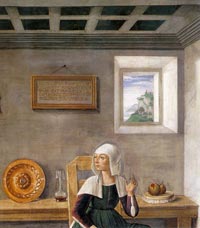
Colleggiata, Announcement of Death to St Fina, by Domenico Ghirlandaio
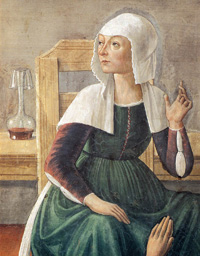
|
The scene on the left wall portrays the Funeral of Saint Fina. The saint is on her funeral bier, lying on a richly decorated brocade cloth, her head supported on a pillow.
For her obsequies, in stark contrast, the beautiful saint is lying not on her wooden bed, but on a rich cloth and pillow in front of the altar. The living flowers have been changed into gold brocade that is shining on the black and dark turquoise cloth. Let us follow the inscription on her grave and look for the miracles depicted on the walls. Because the old nurse had held Fina's head for so long, her arms became paralysed. Now, kneeling behind the bier in the centre of the scene, she is healed by the touch of Saint Fina's hands. Another healing is taking place at the feet of the dead woman. Here, a blind boy regains his sight by touching his eyes to the saint's feet. A third miracle is taking place in the background on the left, where an angel has appeared to ring the death knell.
The painted pilasters that flanked the front pictorial zone of Ghirlandaio's early works are now integrated into the background of the picture as parts of a monumental sacred architecture. Behind the scene is an apse, which harmonizes with the chapel wall's tympanum at the top, and which also guides our eyes back to the centre of the scene. The vanishing point in this composition is the altar cross-flanked by two candles. Ghirlandaio would have found models for this architecture, which skillfully uses colourful marble, in the monumental tombs of his age - such as the work of Bernardo Rossellino in the church of Santa Croce in Florence. The immediate inspiration for the composition, however, was Fra Filippo Lippi's fresco in the choir of Prato Cathedral, the Obsequies of Saint Stephen. Ghirlandaio would later create another variation on this composition in a fresco for the Sassetti Chapel in Florence.
In the long row of expressive heads Ghirlandaio already reveals his unique ability to create convincing character studies, a skill that was to bring him fame and many well paid commissions. Some of those depicted do not seem to be taking part in the ceremony, while others are deeply moved. The server at the saint's feet is more interested in his processional cross than in the ceremony, and the server next to him is looking around to keep himself amused.
In the lower left corner on of the miracles can be seen: a blind choirboy who kisses her foot regains his sight.
Vaulting of the Chapel of St Fina
In addition to the two large pictures on the side walls, the painted decor of the Chapel of St Fina includes six large prophets in the spandrels, the four evangelists in the tondi of the vaulting, and in the lunettes at the level of the round window the four Latin Church fathers, and the city patrons, Gimignano and Nicholas of Bari. Earlier these paintings were attributed to Bastiano Mainardi, who was born in SanGimignano and is considered Ghirlandaio's most important pupil. However, now it is thought that it was Ghirlandaio himself who planned the painting of the vaulting and the spandrels and executed some of it himself.
Art in Tuscany | Domenico Ghirlandaio | The Santa Fina Chapel in the Chiesa Collegiata, San Gimignano
|
|
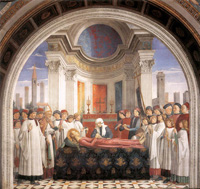 Funeral Rites
Funeral Rites
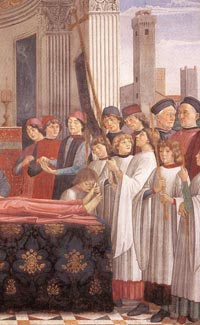
Colleggiata, Obsequies of St Fina (detail),
|
|
|
|
| |
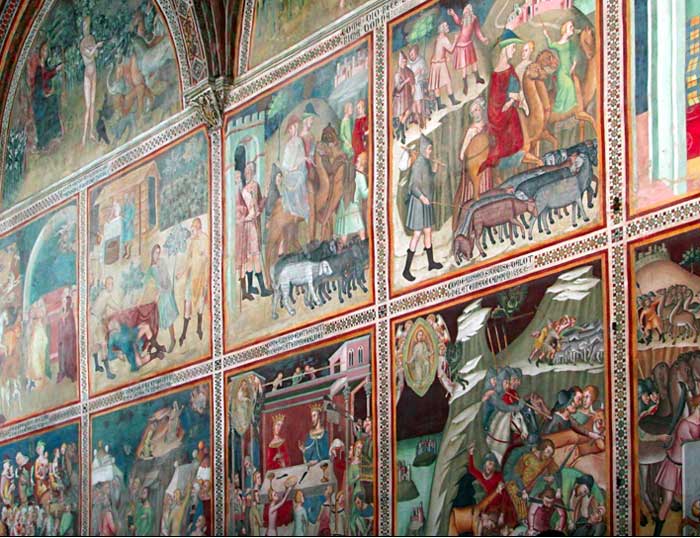 |
Bartolo di Fredi, Storie del Vecchio Testamento, affreschi, Collegiata di San Gimignano
|
Old Testament cycle
The wall of the left aisle had six decorated bays, of which the paintings of the first bay are in poor condition and those of the sixth have been damaged and in part destroyed by the insertion of the pipe organ. The remaining paintings, with the exception of a repainted panel in the sixth bay, are the work of Bartolo di Fredi, and, according to an inscription, were completed around 1356.[12] The paintings are in three registers and proceed from left to right chronologically in each register.[12]
Upper level
|
The upper register occupies the lunettes beneath the vault and depicts the story of Creation. [12]
Creation of the Firmament
Creation of Man
Adam names the animals
Creation of Eve
God commands Adam and Eve not to touch the forbidden fruit
The Original Sin (lost)[12]
Middle level
The second register has ten remaining scenes, with two at the furthest right having been lost with the insertion of the organ.[12]
The Expulsion of Adam and Eve from the Garden of Eden (very incomplete)
Cain kills Abel (very incomplete)
Noah and his family building the Ark
Animals entering the Ark
Noah and his family giving thanks after the Great Flood
The Drunkenness of Noah
The departure of Abraham and Lot from the land of the Chaldeans
Abraham and Lot go separate ways.
Joseph's dream
Joseph is put into a well by his brothers
Story of Joseph in Egypt (lost)
Story of Joseph in Egypt (lost) [12]
|
|
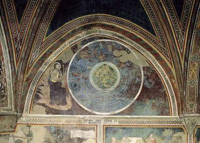
Bartolo di Fredi (1330-1410), Creation of the Universe, fresco, Collegiate Church, San Gimignano
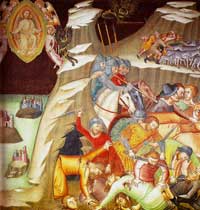
Bartolo di Fredi (1330-1410), Destruction of Job's Servants (detail)
|
The second register has ten remaining scenes, with two at the furthest right having been lost with the insertion of the organ.[12]
The Expulsion of Adam and Eve from the Garden of Eden (very incomplete)
Cain kills Abel (very incomplete)
Noah and his family building the Ark
Animals entering the Ark
Noah and his family giving thanks after the Great Flood
The Drunkenness of Noah
The departure of Abraham and Lot from the land of the Chaldeans
Abraham and Lot go separate ways.
Joseph's dream
Joseph is put into a well by his brothers
Story of Joseph in Egypt (lost)
Story of Joseph in Egypt (lost) [12]
Lower level
|
|
|
In the lower register, there are ten scenes.[12]
Joseph, has his brothers arrested (very incomplete)
Joseph makes his identity known to his family (incomplete)
Moses changes the rod into a serpent
The army of Pharaoh are drowned in the Red Sea. (this scene occupies two sections)
Moses on Mount Sinai
The devil is sent to Job by God
The men and herds of Job are killed
The house of Job falls, killing his sons.
Job prays to God
Job, plagued by boils, is visited by friends. (incomplete)
(Lost scene)[12]
Upper level
|
|
|
New Testament cycle
The six decorated bays of the right aisle, with scenes of the New Testament, pose a problem of authorship. Giorgio Vasari states that they are the work of "Barna of Siena" and relates that Barna fell to his death from the scaffolding.[13] The name "Barna" in relation to paintings at the Collegiate Church of San Gimignano appears to have originated in Lorenzo Ghiberti's Commentaries. In 1927 the archivist Peleo Bacci made the suggestion that Barna had never existed and that the paintings are the work of Lippo Memmi. This hypothesis received no support and little comment for fifty years.[14] In 1976 discussion of Bacci's attribution was revived, with Moran suggesting that there had been a mis-transcription of "Bartolo" as "Barna", with the name "Bartolo" referring to Bartolo di Fredi, painter of the Old Testament cycle.[15]
The attribution of the New Testament cycle to Lippo Memmi, perhaps assisted by his brother Federico Memmi and father Memmo di Filippucci, is now generally agreed.[14] Lippo Memmi was influenced by his more famous brother-in-law, Simone Martini.[8] Lippo Memmi also painted a large Maesta in the Town Hall of San Gimignano, in imitation of that done by Simone Martini at the Town Hall of Siena. The New Testament cycle of the right aisle appears to pre-date the Old Testament cycle and is generally accepted to date from c.1335-1345.[16]
The scenes within the New Testament cycle are organised into four separate narratives, and do not follow a clear left-to-right pattern as do those of the left aisle. As with the left aisle, they are divided into three registers, the upper being the lunettes between the vaults.[16]
Upper level
|
The upper register shows the Birth of Christ. The series reads from right to left, in six bays. [16]
The Annunciation
The Nativity and adoration of the shepherds
The adoration of the Magi
The Presentation at the Temple
The Massacre of the Innocents
The Flight into Egypt[16]
Middle level
The middle register shows scenes of the Life of Christ, beginning at the 4th bay, below the picture of the Presentation at the Temple, and reading left to right, with eight scenes.[16] The scenes have been skilfully juxtaposed so that narrative elements may be compared or contrasted. Within the fourth bay is shown the Presentation of the Temple, Jesus sitting among the Doctors of the Temple of Jerusalem as a twelve-year-old, and Jesus before his crucifixion, enthroned, crowned with thorns and mocked. [16]
Jesus among the Doctors of the Temple of Jerusalem
The Baptism of Jesus
The Calling of Peter
The Wedding at Cana of Galilee (damaged in WWII)
The Transfiguration
The Resurrection of Lazarus
Jesus enters Jerusalem
The people welcome Jesus to Jerusalem (the final two scenes are a single event spread over two frames)[16]
Lower level
The lower register, showing the Passion of Christ, continues beneath the Entry into Jerusalem, and is read from right to left in eight scenes over four bays.[16]
The Last Supper
Judas agrees to betray Jesus for thirty pieces of silver
Jesus prays in the Garden of Gethsemane
The Kiss of Judas
Jesus at the Praetorium
The Scourging of Jesus
Jesus crowned with thorns and mocked
Jesus carrying the cross to Calvary [16]
Bays five and six
|
|
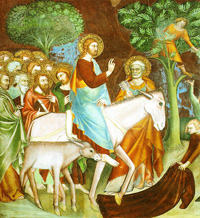
Lippo Memmi, The people welcome Jesus to Jerusalem
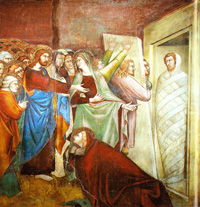
Lippo Memmi, The Resurrection of Lazarus
|
Bay five, beneath the lunette of the Slaughter of the Innocents, has a single large scene of the Crucifixion.[16]
Bay six, beneath the lunette of the Flight into Egypt contained four scenes (destroyed in the 15th century) of post-crucifixion events[16] which are thought to have been:
The Deposition
The Descent into Limbo
The Resurrection
Pentecost
The Last Judgement by Taddeo di Bartolo
|
|
Lippo Memmi, Judas receives the thirty pieces of silver,
|
This scene is painted in fresco on the inner wall of the facade and the adjoining walls of the nave. The work was completed in 1493 by Taddeo di Bartolo, one of the foremost Sienese painters of the 14th century.
Taddeo di Bartolo was a sienese painter, active in Pisa, Perugia, San Gimignano, and Volterra, his native city.
He was a conservative artist, but is noteworthy for his series of frescos on Roman Republican heroes and civic Virtues (1406-14) in the Palazzo Pubblico, Siena, which are early examples of a type that became popular in the Renaissance.
The central section of the Last Judgement shows the figure of Christ as Judge, accompanied by the Virgin Mary and St John, with the Apostles. On the right wall is the image of Paradise, in a ruined state. On the left side Hell is represented, along with various depictions of the gruesome torments to be suffered by those who commit and of the Seven Deadly Sins.[17]
On the rear wall of the nave, beneath the Last Judgement is a fresco of the Martyrdom of St Sebastian painted by Benozzo Gozzoli in 1465. The work was commissioned by the people of San Gimignano as the result of a vow that they made to honour the saint, whose intervention was believed to have brought relief from an outbreak of plague in 1464. The painting shows the figure of Christ and the Virgin Mary in Glory, while below, St Sebastian, standing on a Classical plinth and bristling with arrows, suffers martyrdom and is crowned by angels.[20]
|
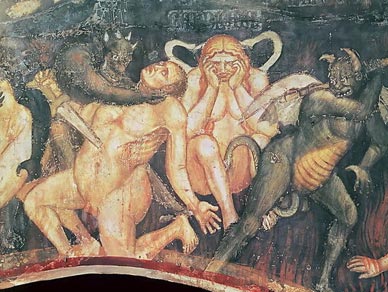 |
|
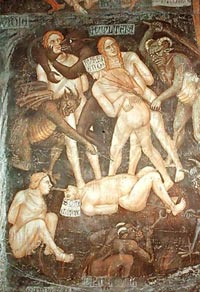 |
Taddeo Di Bartolo, The Last Judgement, detail of the adulterers and The Lustful, c.1394,
San Gimignano, Collegiata
|
|
|
Chapel of the Conception
The chapel was built in 1477 and modified in the 17th century. The side lunettes have frescoes by Niccolo di Lapi representing the Birth of the Virgin and St Philip Neri celebration mass. The vault shows the Coronation of the Virgin painted by Pietro Dandini. The altarpiece is the Virgin of the Immaculate Conception by Ludovico Cardi, late 16th century.[19]
Other artworks
St Sebastian by Benozzo Gozzoli
|
Benozzo Gozzoli, had received his training under Lorenzo Ghiberti while working on the Baptistry doors.[20] He fulfilled two other important commissions in San Gimignano.
Along with the original commission to fresco the choir of Sant'Agostino in San Gimignano, Gozzoli received a number of other requests. For the Sant'Agostino, Gozzoli created a votive fresco showing St Sebastian Intercessor on the southern nave wall. This work was painted during the outbreak of the plague in 1464, as we are informed by the inscription on the saint's pedestal. This would mean that Gozzoli interrupted the painting of the apsidal chapel in order to produce this picture.[21]
Gozzoli painted in San Gimignano another fresco of St Sebastian on the inner entrance wall of the collegiate church of Santa Maria Assunta. The work as commissioned by the city government in February 1465, six months after the plague epidemic.
On this occasion the saint is depicted in accordance with the iconographical tradition of Italian art during the 15th century. The saint provided artist with an opportunity to depict a nude, which is why the theme was particularly popular from the Renaissance onwards. The arrows which his tormentors are pointing at him symbolize a sudden illness. The similarity of a body transfixed with arrows and that of a plague victim makes the choice of Sebastian as a plague saint appear plausible.
Much of the painting was executed by assistants.
|
|
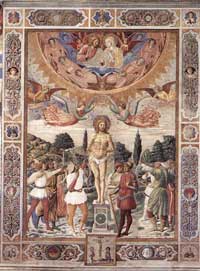 The Martyrdom of St Sebastian
The Martyrdom of St Sebastian by Benozzo Gozzoli (1465) honours the saint who was invoked in times of plague. |
The Annunciation
In the Baptistery Loggia to the south of the church are several small frescoes of saints, and a major work, The Annunciation, previously attributed to Ghirlandaio but now believed to be the work of Sebastiano Mainardi and dated to 1482.[10] In front of The Annunciation stands the font, which was removed from the church and placed in this position in 1632. It is hexagonal, with a sculptured relief on the side, that to the front being the Baptism of Christ, with the two adjoining panels containing kneeling angels. It is the work of the Sienese sculptor Giovanni di Cecco and was commissioned by the Wool-workers Guild in 1379.[10]
It was supposedly Bastiano Mainardi, using the design of his brother-in-law, Domenico Ghirlandaio, who painted this fresco of Annunciation about 1482 in his native town of San Gimignano. This is largely a poor imitation of Leonardo's famous Annunciation. Only the lectern, the details of which are reminiscent of Flemish still-lifes, shows originality.
|
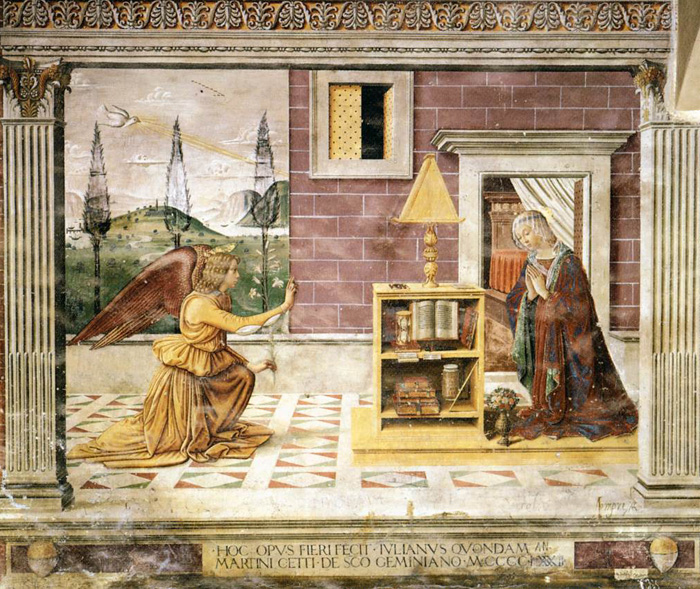 |
Sebastiano Mainardi, Annunciation, c. 1482, fresco, Baptistry Loggia, Collegiata, San Gimignano
|
Vasari mentioned that Mainardi was a pupil of Domenico Ghirlandaio and that he was still working in the studio at the time of his master’s death. Vasari also claimed that Mainardi collaborated with Ghirlandaio on several works between 1475 and 1477, including the fresco decoration of the chapel of S Fina in the Collegiata, San Gimignano, and on the frescoes in the abbey of Passignano in Val di Pesa, near Florence. Given the dates of these works, it was thought that Mainardi was born between 1450 and 1460 and that he was, if not a contemporary of Ghirlandaio’s, certainly one of his earliest collaborators, together with Ghirlandaio’s brother Davide. The discovery that Mainardi was born in 1466 (Venturini) would suggest that the two painters’ relationship was that of master and pupil, at least until the early 1480s. Certainly Mainardi could not have collaborated on the frescoes in the Collegiata.
Works by Jacopo della Quercia and others
The Annunciate angel and the Virgin Mary, two figures carved in wood by Jacopo della Quercia stand towards the end of the nave. They were created around 1421 and later decorated with polychrome by Martino di Martolomeo. [20]
Pope Gregory predicts the death of St Fina, an early 14th-century fresco in a lunette of the right nave arcade, thought to be the work of Nicolo di Segna di Bonaventura.[18]
The main altar of the church has a large marble ciborium and two kneeling angels with candlesticks, the work of Benedetto Maiano, created at the same time as the altarpiece and tabernacle in the Chapel of Santa Fina, 1475.[22]
The crucifix of the chancel is by the Florentine sculptor, Giovanni Antonio Noferi, 1754. Noferi also designed the marble pavement of the chancel. [22] |
|
|
|
![]()
![]()
![]()
![]()
![]()

